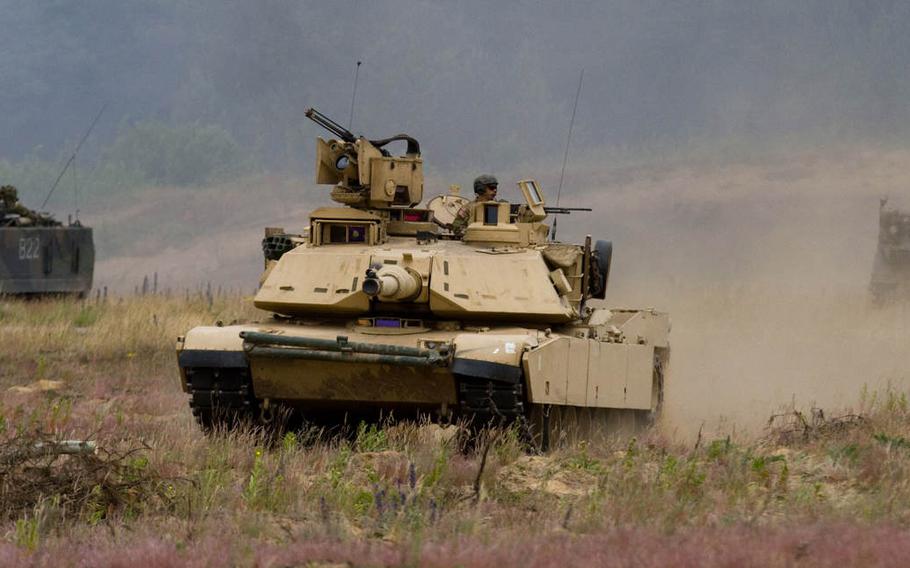
A U.S. Army Abrams M1A2 tank leads the charge during a battle demonstration along with two Lithuanian Land Forces M113 armored personnel carriers June 18, 2015, during the final day of Saber Strike 2015 at the Great Lithuanian Hetman Jonusas Radvila Training Regiment. (James Avery/U.S. Army)
BRUSSELS — NATO’s top military commander got new powers Wednesday to mobilize troops more quickly for deployment as defense ministers sought to make the alliance more nimble in responding to crisis situations.
Gen. Philip Breedlove, NATO’s supreme allied commander, was previously unable to stage troops without going through a cumbersome approval process. He still must await political approval before deploying members of the new rapid-reaction Spearhead Force, but the approval process has been streamlined and Breedlove will be able to ready forces while waiting for the green light.
The new powers grant Breedlove the authority to “alert, stage and prepare our troops to be ready to go,” NATO Secretary-General Jens Stoltenberg said as alliance defense ministers wrapped up the first of two days of talks.
Streamlining the process was imperative to make quick-reaction forces — NATO’s Spearhead Force is expected to be deployable within 48 hours — a reality rather than a concept, Stoltenberg said.
“This will enable us to deploy our forces as quickly as we need when crises arise, while maintaining full political control,” he said.
The alliance also decided to add new elements to its larger response force, which is set to more than double to as many as 40,000 troops. Those measures include new air, sea and special-forces elements.
“This is a substantial increase compared to the previous level of 13,000 troops,” Stoltenberg said.
At the heart of the response force is NATO’s new Spearhead unit of 5,000 troops, which the U.S. will contribute to with a host of enabling capabilities such as strategic airlift, air-to-air refueling and special operations forces.
Collectively, the moves are part of the alliance’s attempts to better position itself to confront new and old threats.
In the east, the alliance faces a resurgent Russia, which has raised tensions not felt since the Cold War. In the south, the Islamic State and other militant groups in the Mideast and Africa seek to extend their reach.
For NATO, Russia’s intervention in Ukraine last year has served as a spark to reinvent itself after a decade of fighting in Afghanistan. During the past year, the alliance has nearly doubled the number of exercises it has conducted in Europe, with forces focused on initiatives in the Baltics and other parts of eastern Europe.
NATO, which already approved new staging bases in six countries in the east — Estonia, Latvia, Lithuania, Poland, Romania and Bulgaria — defined the makeup of those facilities, which are intended to help plan and manage regional exercises. Each of those bases will have 40 personnel and will be operational by the end of the year. Allies also are looking at more potential locations in the future, Stoltenberg said.
A new logistics headquarters will be set up to help mobilize troops and equipment across Europe.
Also Wednesday, NATO approved a plan to step up support for non-NATO member Moldova, which is wary of Russia’s intentions given Moscow’s support for the breakaway region of Trans-Dniester. The alliance will establish a new defense “capacity-building package to help Moldova enhance its defense and security institutions,” Stoltenberg said.
In the West, there have long been concerns that Moldova could be a potential target for Russian aggression.
While Russia has accused NATO of escalating tensions with its focus on the Baltics and eastern Europe, Stoltenberg described the alliance’s eastward push as defensive in nature.
On Monday, Defense Secretary Ash Carter announced a long-expected move by the U.S. to pre-position tanks and other armored vehicles in the Baltics, Poland, Romania and Bulgaria. The measure is aimed at facilitating a more robust training mission in the region, which is funded in part by America’s nearly $1 billion European Reassurance Initiative.
Positioning 250 armored vehicles in strategic locations is also expected to give NATO a readiness boost.
Stoltenberg welcomed the U.S. decision, which coupled with its support for NATO’s Spearhead Force, “completes the picture” of the alliance efforts to improve readiness.
Across NATO’s eastern flank, there has been considerable stress in the wake of Russia’s aggression in Ukraine.
Speaking at a NATO war game in Poland last week, Polish Defense Minister Tomasz Siemoniak underscored those concerns when he talked of a new security environment in Europe that reflected the anxiety felt by many allies in the east.
“The peaceful period after the Second World War is over,” Siemoniak said. “We cannot defend our European way of life if we don’t do more for our defense.”
Turbulence isn’t restricted to NATO’s eastern flank. In the south, the Islamic State group now operates within miles of NATO partner Turkey.
Stoltenberg emphasized that the alliance’s growing response force could be called upon for missions anywhere it is needed.
“We do not seek confrontation. And we do not want a new arms raise. We want to keep our nations safe,” Stoltenberg said. “And faced with many challenges from many directions, we need to be prepared.”